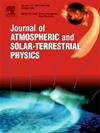Solar terminator related variations in geomagnetic field
IF 1.9
4区 地球科学
Q3 GEOCHEMISTRY & GEOPHYSICS
Journal of Atmospheric and Solar-Terrestrial Physics
Pub Date : 2025-04-15
DOI:10.1016/j.jastp.2025.106517
引用次数: 0
Abstract
The solar terminator is a global, regular source of disturbances in various parameters of the Earth's atmosphere. The main feature of the solar terminator is its stability and precise regularity. To estimate the regular effects from the solar terminator in geomagnetic data, an analysis of averaged variations in the geomagnetic field components was performed based on long magnetic field time-series over the past 24 years from a large number of geomagnetic observatories. It was demonstrated that in addition to quasi-semidiurnal oscillations, Sq variations of the geomagnetic field contain relatively weak regular oscillations with periods of less than an hour, precisely tied to the moment of sunrise and sunset (passage of the solar terminator), as well as the passage of the terminator through the magnetically conjugate point.

与太阳终结期有关的地磁场变化
太阳终结点是地球大气各种参数扰动的一个全球性的、有规律的来源。太阳终端机的主要特点是其稳定性和精确的规律性。为了估计太阳终止期对地磁数据的规律性影响,基于大量地磁观测站过去24年的长磁场时间序列,对地磁分量的平均变化进行了分析。结果表明,除了准半日振荡外,地磁场的Sq变化还包含相对较弱的规则振荡,周期小于1小时,精确地与日出和日落时刻(太阳终端线通过)以及终端线通过磁共轭点的时刻相关联。
本文章由计算机程序翻译,如有差异,请以英文原文为准。
求助全文
约1分钟内获得全文
求助全文
来源期刊

Journal of Atmospheric and Solar-Terrestrial Physics
地学-地球化学与地球物理
CiteScore
4.10
自引率
5.30%
发文量
95
审稿时长
6 months
期刊介绍:
The Journal of Atmospheric and Solar-Terrestrial Physics (JASTP) is an international journal concerned with the inter-disciplinary science of the Earth''s atmospheric and space environment, especially the highly varied and highly variable physical phenomena that occur in this natural laboratory and the processes that couple them.
The journal covers the physical processes operating in the troposphere, stratosphere, mesosphere, thermosphere, ionosphere, magnetosphere, the Sun, interplanetary medium, and heliosphere. Phenomena occurring in other "spheres", solar influences on climate, and supporting laboratory measurements are also considered. The journal deals especially with the coupling between the different regions.
Solar flares, coronal mass ejections, and other energetic events on the Sun create interesting and important perturbations in the near-Earth space environment. The physics of such "space weather" is central to the Journal of Atmospheric and Solar-Terrestrial Physics and the journal welcomes papers that lead in the direction of a predictive understanding of the coupled system. Regarding the upper atmosphere, the subjects of aeronomy, geomagnetism and geoelectricity, auroral phenomena, radio wave propagation, and plasma instabilities, are examples within the broad field of solar-terrestrial physics which emphasise the energy exchange between the solar wind, the magnetospheric and ionospheric plasmas, and the neutral gas. In the lower atmosphere, topics covered range from mesoscale to global scale dynamics, to atmospheric electricity, lightning and its effects, and to anthropogenic changes.
 求助内容:
求助内容: 应助结果提醒方式:
应助结果提醒方式:


